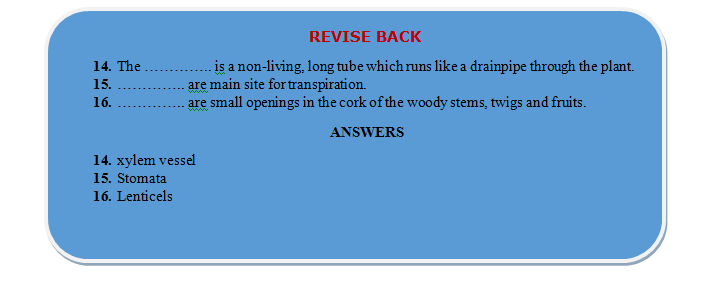
Transportation In Plants
Transportation in animals and plants of Class 7
Transport system in plants is less elaborate than in animals. So, the only substances which are to be supplied to a plant through a transport system are water and minerals (which they can’t get from the air). Another job of the transport system of plants is to transport food prepared in the leaves to the various parts of the plants like stems, roots, etc.
The plants have two transport system :
- Xylem which carries water and minerals, and
- Phloem which carries the food materials which the plant makes (Phloem also carries the hormones made by the plants in their root and shoot tips).
The water and minerals dissolved in it move from the roots of the plant to its leaves through the two kinds of elements of the xylem tissue called xylem vessels and tracheids . Xylem vessels and tracheids are both non-living conducting tissues which have thick walls.
Xylem vessels
- The xylem vessel is a non-living, long tube which runs like a drainpipe through the plant. A xylem vessel is made of many hollow, dead cells (called vessel elements ), joined end to end. The end walls of the cells have broken down so a long, open tube is formed.
- Xylem vessels run from the roots of the plant right up through the stem and reach the leaves. The xylem vessels branch into every leaf of the plant.
- Xylem vessels do not contain the cytoplasm or nuclei. The walls of xylem vessels are made of cellulose and lignin . Lignin is a very hard and strong substance, so xylem vessels also provide strength to the stems and help to keep the plant upright.
Wood
Wood is made almost entirely of lignified xylem vessels. Xylem vessels have pits in their thick cell walls. Pits are not open pores. Pits are the thin areas of the cell wall where no lignin has been deposited. Pits have unthickened cellulose cell wall.
Tracheids
- The tracheids are elongated (5-6 mm dead cells with hard lignified walls, wide lumen and narrow end walls. In outline they are circular, polygonal or polyhedral.
- The walls of tracheids have various types of thickenings for mechanical strength. The unthickened areas allows the rapid movement of water from one tracheid to another.
- Tracheids constitute 90-95% of wood in angiosperms they hardly form 5% of the wood.
The transport of materials in a plant can be divided into two parts :
- Transport of water and minerals in the plant, and
- Transport of food and other substances (like hormones) in the plant.
The transport of water and dissolved sugar and mineral salts takes place by two methods in higher plants.
- Translocation : The phloem translocates the manufactured food (sugar) or starch from the leaves to the different parts of the plant including the roots.
- ranspiration : The water is lost constantly from the surface of the leaves due to transpiration. This produces the pushing (suction) force in the xylem which causes the upward movement of the water along with minerals.
The plants take in water (containing dissolved minerals) from the soil through their roots. This water (containing minerals) called sap is carried by the xylem vessels to all the parts of the plant.
- The roots of a plant have hair called root hairs . The function of root hairs is to absorb water and minerals from the soil. The root hairs are directly in contact with the film of water in between the soil particles. Water (and dissolved minerals) get into the root hairs by the process of diffusion.
- The water and minerals absorbed by the root hair from the soil pass from cell to cell by osmosis through the epidermis, root cortex, endodermis and reach the root xylem.
- The xylem vessels of the root of the plant are connected to the xylem vessels of its stem. So the water (containing dissolved minerals) enters from the root xylem vessels into stem xylem vessels. The xylem vessels of the stem branch into the leaves of the plants.
Stomata
Stomata are main site for transpiration. The term stomata was given by Malphighi. Stomata are the openings found an the epidermis of leaves & young stems. It is responsible for about 90-97% of the total foliar transpiration.Stomata are mostly found on the lower surface of the leaf, but may occur on both the surfaces. With the exception of few submerged hydrophytes, stomata are widely distributed amongst angiosperms and gymnosperms. Functional stomata are also found in some primitive vascular plants (e.g., horsetails) and mosses.
- Cuticular transpiration : Water vapour is also lost directly from the outer walls of the epidermal cells through the cuticle. Cuticle is a wax-like layer of cutin that covers the epidermis of leaves and stems. It reduces the water loss but is not completely impermeable to water vapour. The thicker is the cuticle, lesser is the amount of transpiration. In plants with thick cuticle, cuticular transpiration is insignificant. Cuticular transpiration amounts for about 3-10% of the total foliar transpiration.
- Lenticular transpiration : Lenticels are small openings in the cork of the woody stems, twigs and fruits. Water vapour is lost through these openings. The amount of water vapour lost through lenticels is usually insignificant (approximately 0.1% of the total water loss). However, in deciduous trees, which shed their leaves during autumn, lenticular transpiration can be significant. According to Huber (1956) only 0.1% water is lost by bark.







